Sorry for being late with this. Real life, and all that. We’ll be back on track with “Genesis” on Friday.
“Eye of the Beholder”
Written by Brannon Braga and Rene Echevarria
Directed by Cliff Bole
Season 7, Episode 18
Production episode 40276-270
Original air date: February 28, 1994
Stardate: 47622.1
Captain’s Log: One of the nacelles is malfunctioning. Riker and Worf discover that Lieutenant Daniel Kwan is threatening to jump into the plasma stream. Riker tries to talk him down long enough for Worf and Lieutenant Nara to shut it down, but they’re not fast enough. After rambling on about people laughing at him and such, Kwan says, “I know what I have to do,” jumps into the plasma stream, and is incinerated.
The crew is devastated. Riker wishes he had a few more seconds, and says that Kwan seemed fine just the other day when the nacelle refit was finished. Picard has never had to do a death notification to a family member where it was a suicide. He puts Worf and Troi in charge of the investigation into Kwan’s death.
They find a picture of Ensign Calloway by his bed, and his last personal log is simply expressing pleasure that the nacelle refit was done and he was looking forward to spending time with Calloway. Troi talks to both Calloway and Nara, who was his supervisor, and they are just as shocked and confused by all this. Calloway describes him as sensitive and happy, Nara as ambitious and a good worker; neither has any idea why he killed himself.
When she walks toward the plasma stream, Troi gets an intense empathic impression of fear, rage, and panic from—well, nobody. Kwan’s mother was Napean, a telepathic species, so it’s possible that the impressions are left over from him.
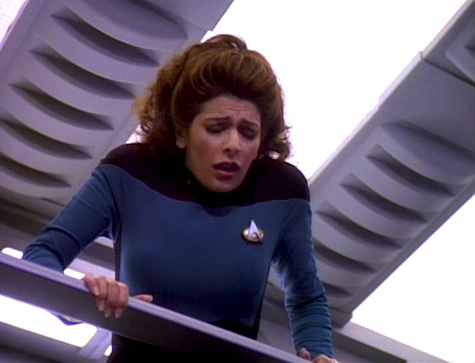
Worf checks on Troi, who still finds nothing in Kwan’s personal logs to indicate why he did this. After the two of them have a pleasant conversation, Worf suddenly gets antsy and leaves, going to Ten-Forward, where he makes the lamest attempt to ask for Riker’s permission to date Troi it’s possible to make.
Later, Troi again visits nacelle control, and this time she sees a man and a woman in engineering jumpsuits, the woman scared and screaming, the man angry—and then Troi finds herself still in nacelle control, but when the Enterprise was still at the shipyards. She walks in on two people making out, one of whom is the woman she saw screaming, but she’s smooching with a different man—they both start laughing—
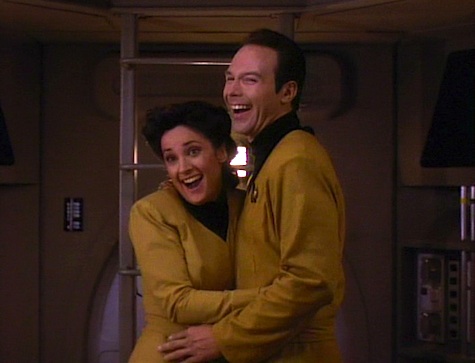
—and then Troi’s back in the present, with Worf getting her attention.
Troi recalls only bits and pieces of what happened, and she has no idea who the woman or the man smooching her are, but the other man looks vaguely familiar. Crusher will synthesize an inhibitor that will allow Troi to go back to nacelle control without being overwhelmed, and then maybe she can pick out more details. But it’ll take time to find, so meanwhile Troi goes through the personnel records of Utopia Planitia from eight years earlier when the Enterprise was being constructed. She finds the angry man, Lieutenant Pierce, who transferred back to the Enterprise six months earlier and is now serving in engineering. He and Kwan both worked together at Utopia Planitia.
Worf and Troi question him, and he professes ignorance about anything that might have happened eight years earlier—but they both know he’s holding something back, the former from his security training, the latter from her empathic abilities. Pierce can actually block Troi’s empathy, which is odd from a human. The two retire to Troi’s quarters, and then they smooch and fall into bed together.
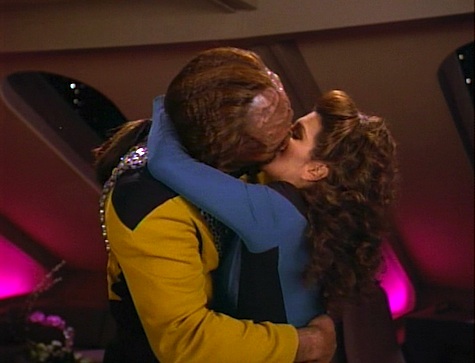
The next morning, Crusher gives Troi the inhibitor, but Worf can’t accompany her to nacelle control right away due to issues with the medical supplies the ship is transporting. Worf is assisting Calloway, and they seem almost flirtatious, which irks Troi a bit.
At nacelle control, Troi asks about a plasma conduit, which it turns out Kwan was working on the day before he died. Nara also says that that was the first time that conduit had been opened since the ship was built.
As soon as La Forge opens the panel at Troi’s request, she sees the woman screaming again, with Pierce standing over her. Data and La Forge detect organic matter in the bulkhead—and they find a skeleton. Extracting it from the wall, the bone fragments are brought to sickbay. Crusher says they’ve been in the wall for seven or eight years, and Calloway starts comparing the DNA profile to Starfleet records. Worf stands over her, again irking Troi.
The DNA matches Ensign Marla Finn, who was declared missing from the shipyards eight years earlier. But Kwan didn’t report to Utopia Planitia until six months after Finn’s death, so Troi can’t have been seeing through Kwan’s eyes. Then she realizes that her impression of Pierce was a reflection—she saw through his eyes. Worf goes to talk to Pierce again while Troi, who’s a bit out of it from the inhibitor, goes to her quarters.
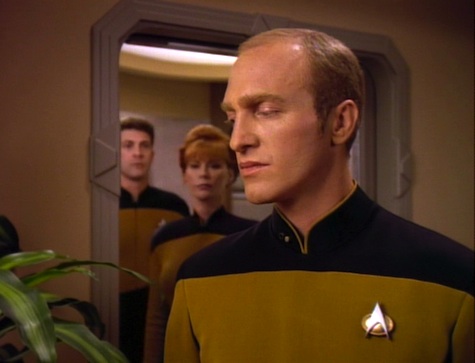
Then Pierce shows up at her door. Troi calls security, which confuses Pierce, as Worf told him to report to her. Troi asks the computer to locate Worf—who is in Calloway’s quarters. She has the security team that shows up escort Pierce to his quarters to hold him there, and Troi then heads to Calloway’s cabin, only to find Worf and Calloway smooching. And then they laugh at her, the same way Finn and the other man did in her earlier vision. Angry, Troi grabs a phaser and shoots Worf, killing him. Troi runs through the corridors—bumping into Pierce, who smiles and says, “You know what you have to do”—and then heads to nacelle control. Just like Kwan, she says, “I know what I have to do.”
But before she can jump, Worf grabs her and pulls her back. It turns out that everything that happened since she first hallucinated Utopia Planitia was in her mind and only took a few seconds of real time. Data digs up the shipyard records, and finds that Pierce, Finn, and the other guy were all killed in what was considered an accident. Pierce is a quarter Betazoid, which makes him telepathic enough to have left an impression in the plasma stream when he died. Troi guesses that Pierce found out that Finn and the other one were having an affair, and he killed them and then staged the accident to a) commit suicide and b) cover up the evidence of his murder.
Can’t We Just Reverse the Polarity?: Apparently, if someone who’s one-quarter telepathic is incinerated by a plasma stream, it leaves enough of a psychic residue to make anyone else who’s telepathic be so overwhelmed by said residue that they will commit suicide also. Which kinda sucks for them.
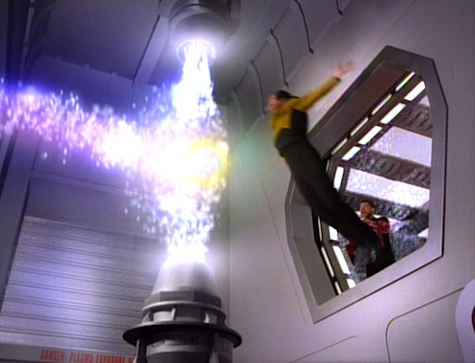
Thank You, Counselor Obvious: Troi spends half the episode in a fugue state where she gets to knock boots with Worf, find him in the arms of another woman, and then kill him.

If I Only Had a Brain…: Data reveals to La Forge that he, after a fashion, considered suicide. Shortly after his activation, he struggled with sentience, risking cascade failure with each new neural pathway created in his positronic brain. The difficulties led him to contemplate shutting himself down and starting over, but he decided that these were challenges to be overcome rather than obstacles to be avoided.
There is No Honor in Being Pummeled: Worf is seriously considering courting Troi following the events of “Parallels,” but he doesn’t feel comfortable doing so without Riker’s blessing. However, his attempt to get that blessing is awkward and ridiculous and hilarious.
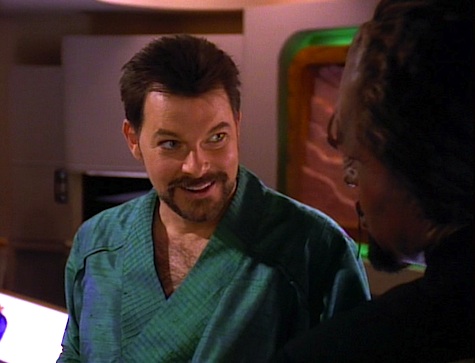
No Sex, Please, We’re Starfleet: There’s quite a lot happening sexually in this episode. Kwan and Calloway had a pretty strong relationship, and she’s confused by his suicide (it’s possible she’s also devastated, but Johanna McCloy utterly fails at conveying that). Riker is making the moves on a Lieutenant Corell in Ten-Forward. Worf starts making the first tentative steps toward possibly seeing Troi romantically, which Troi has picked up on enough of to have it influence her hallucination, and she and Worf do the deed. Then, later in the hallucination, Worf and Calloway are smooching. And the whole mishegoss started because of an affair Finn and another guy had when Finn was dating Pierce back on Mars. Wah-hey!
I Believe I Said That: “Well, you know what they say, Mr. Worf: hell hath no fury like a woman scorned.”
Troi’s response to Worf’s question of how he was killed in her hallucination, which she answers by misquoting William Congreve. (The actual quote from The Mourning Bride: “Heaven has no rage like love to hatred turned, / Nor hell a fury like a woman scorned.”)
Welcome Aboard: Nancy Harewood and Johanna McCloy are barely adequate as Nara and Calloway, respectively—though I would’ve expected the love of Kwan’s life to be a lot more broken up. I mean, Jonathan Frakes showed more emotion over Kwan’s death than the woman playing his girlfriend. As Kwan, Tim Lounibos does the best he can with a part that just calls for him to stand in place muttering seeming nonsense before jumping. Longtime extra Nora Leonhardt gets something resembling a speaking part—no dialogue, but she gets to scream and laugh—as the image of Finn. (Amusingly, Leonhardt also was Marina Sirtis’s usual stand-in, but her role as Finn kept her from doing that this episode, so that role went to Second Assistant Director Arlene Fukai.)
But this episode’s Robert Knepper moment is longtime character actor Mark Rolston, who has made a career playing hardasses and nasty folks, as Pierce.
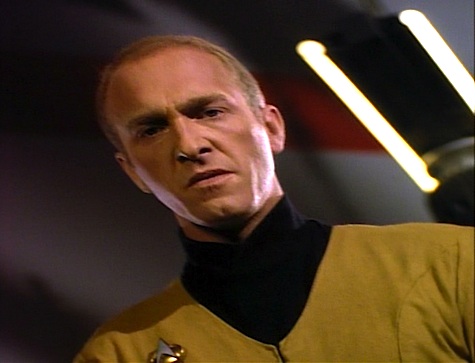
Trivial Matters: The Utopia Planitia Fleet Shipyard was first referenced (and seen in holographic form) in “Booby Trap.”
Troi references talking to Kwan during the crew evaluations, which occurred in “Lower Decks.”
Picard says that the warp speed limits are suspended for their medical mission, yet another reference to “Force of Nature” for the express purpose of working around what that episode established.
Worf mentions seeking visions in fire, something we saw him try in “Rightful Heir,” both in his quarters and on Boreth.
Make it So: “They laughed at me!” This isn’t a bad episode, exactly. It’s an interesting little mystery that has a science fictional twist, though the upshot that telepaths are helpless before the power of eight-year-old psychic residue is a little—odd? I mean, seriously, Kwan and Troi both were driven to take their own lives just from the impressions of Pierce’s murder-suicide?
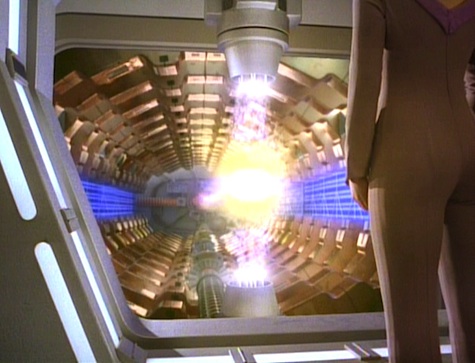
I had misremembered that all of this episode was in Troi’s head, but it’s only about half of it. For one thing, that means that Worf’s awkward conversation with Troi followed by his hilarious attempts to ask for Riker’s permission really did happen, which is a nice bit of progress on that front, and I loved Data’s admission to La Forge that he considered a form of suicide early on after his activation. (I also like the way Data folds his arms the same way La Forge does when he confides in him.) In addition, in a surprising twist for TNG, the ending is kind of unresolved. There’s no way to prove what happened on Utopia Planitia, and it wouldn’t much matter anyhow, since the person responsible is also dead. I would’ve liked to have seen more done with the consequences here—I mean, Pierce managed to, in essence, commit another murder eight years after he died. That would seem to be worth talking about.
Still, overall, I get a sense of meh. The guest casting doesn’t help—Johanna McCloy is pretty nowhere as Calloway, and just the act of casting Mark Rolston kinda points to Pierce being our bad guy.
Warp factor rating: 5
Keith R.A. DeCandido has two new books out, neither of which are actually SF/F: the novel Leverage: The Zoo Job, based on the TV series about criminals who help people, and the baseball book In the Dugout: Yankees 2013, which he co-edited with Cecilia M. Tan, all about New York’s American League baseball team.










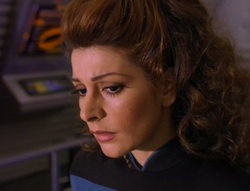
Honestly, I couldn’t even push play I remember this one being so bad.
I keep getting the name Mark Rolston confused with Mark Raxton, the Molten Man from Spider-Man comics. Although the main role I know Rolston from is the voice of Lex Luthor on Young Justice.
This episode is an example of how the Next Generation Technical Manual was influencing the writing/production by this point, because the depiction of the nacelle interior is very similar to what’s in that book — although they simplified it by, rather nonsensically, having only one plasma injector for the whole nacelle, rather than one for each warp coil as in the manual. I guess that was cheaper to animate. Still, it’s neat to see a nacelle from the inside. Except that I’ve always found it implausible that a warp nacelle, especially an active one, could be a place where crewmembers could actually occupy and work in. I mean, Matt Jefferies’s basic rationale in putting the engines in outboard nacelles on long pylons was the assumption that they’d give off so much radiation that it wouldn’t be safe to get anywhere near them while they were active. Not to mention the sheer heat given off by that plasma stream. Even if we accept the ridiculous pretense that a thin, invisible forcefield is able to block all that stellar-level heat and radiation, Kwan should’ve vaporized the instant he stepped through the field, before even getting to the actual plasma stream. Nobody who makes TV or film has a clue when it comes to thermodynamics.
And that’s really the one thing that’s stood out in my mind about this episode — except for the realization that if Roddenberry had still been alive at this point, he wouldn’t have allowed a story about Starfleet officers involved in sexual betrayal, jealousy, murder, and suicide. Usually Rick Berman was pretty emphatic about keeping the franchise true to those parameters, so it’s surprising to see them so severely bent here. Maybe the fact that the culprit was so far in the past (although only a year before the start of the series) made it more acceptable.
I always wondered why this sort of thing hadn’t happened before, since it seems like such a strong effect. Also, how does it get cleaned out? What exactly *is* psychic residue?
…and isn’t a plasma stream an ever-changing sort of thing? How does *any* part of it last for eight years?
It just struck me as a goofy ghost/paranormal story that stumbled into the Trek plot cannon. It’s not awful, it’s just… kinda dumb.
This is the episode that, in my mind, finally bridged the Engineering set design from the original series to the movie/TNG era. Engineering on the original Enterprise seemed to consist of a control room and a large chamber behind a fence or screen ( http://en.memory-alpha.org/wiki/Engineering ). As as kid, I never understood the change to the multi-story tubes seen in later versions. Seeing this episode I had the “epiphany” that they’d spent all those TOS episodes in the nacelle control room. Now I’m sure CLB will correct me. But it made sense at the time. :D
This was among the first new episodes I saw back in 1994 after having missed chunks of seasons 5 and 7 and all of 6 because I was out of the country. I found the mystery and resolution fairly compelling, but don’t recall the flat acting. I need to watch this one again.
BTVS did this much better.
I think the best equivalent of the TOS engineering set is the part of the TNG set with the pool table. Basically a control room for the big machines that are elsewhere. Imagine the TNG engineering set with a big metal screen blocking the pool table area from the shiny pulsing light tube. And really, in TOS they hadn’t thought any farther than “room with control panels”. Take the dilithium chamber. In TNG, the matter/antimatter anihilation reaction takes place inside the dilithium crystal lattice, inside the warp core. In TOS, the dilithium chamber is a cabinet with sliding drawers and the crystals can be pulled out with a handkerchief.
@3: The residue that generated the psychic impression was embedded in the wall panel near the plasma stream, not in the plasma stream itself.
@@.-@: The Constitution-class cutaway seen onscreen in ENT: “In a Mirror, Darkly” (or rather, this clearer version thereof) shows the engine room in the secondary hull, just in front of where the nacelle pylons meet the ship. The angled “tubes” behind the grille are interpreted there as the plasma conduits running from the horizontal warp core beneath the floor of the engine room up to the nacelles. (In my novel Department of Temporal Investigations: Forgotten History, I describe the bowels of the engineering section in a way that combines/reconciles that cutaway with information from the animated series.)
@6: You seem to be describing the engineering set from “The Alternative Factor,” an episode whose depiction of dilithium and antimatter is so contradictory to the rest of TOS that it pretty much has to be dismissed as apocryphal. It treated dilithium as the ship’s power source, while antimatter was a phenomenon from another universe that would completely destroy both universes if it ever came in contact with identical matter. But previous and later TOS episodes consistently depicted the ship as matter-antimatter powered with the (di)lithium crystals as the means by which that power was routed to ship’s systems. It was eventually established that the dilithium crystals were contained within (or at least accessed through) the freestanding unit in the middle of the engine-room set, as seen in “Elaan of Troyius,” for instance. The Drexler cutaway has that unit as the “tip of the iceberg” of the warp reactor underneath, so I assume the frame that rises from the top of the unit with the crystals inside is just the top of a sort of elevator shaft that lowers them into the reactor proper.
When I watched this I actually thought the Worf/Riker conversation was in her head too, I was a bit confused at what was real and what was not. Which is partially why I did start off liking the episode and interested in the mystery, but felt just a bit cheated at the end. I’m not a big fan of ‘it was all a dream’ type endings.
Also, Pierce scared me just by looking at him, and that was before I realized he was the creepy prison guy in Shawshank Redemption.
I think CLB makes a good point though about this type of story being alien to the kind of thing Roddenberry envisioned for his universe. I have not come to a strong opinion if I think that is automatically a terrible thing or not, though.
@7 Great stuff, thanks. The horizontal warp core explains why it’s not visible in TOS, but then the question comes as to why they made it vertical. Other than Rule of Cool.
@6 Imagining a screen blocking the view of the reactor would make sense, if it weren’t clear—no pun intended—that the screen in the original series Engineering set was transparent or a latticed fence. (If I am not mistaken, there was some forced perpective involved, too.) You’re right, though; the location of the pool table is definitely the analog of the original Main Engineering.
My main thoughts on watching this was seeing Mark Rolston and thinking “that’s the serial killer guy from Babylon 5, he’s bound to be the baddie.” Other than that it left very little impression, except some vague thoughts about the physical logistics of Klingon/Betazoid sex.